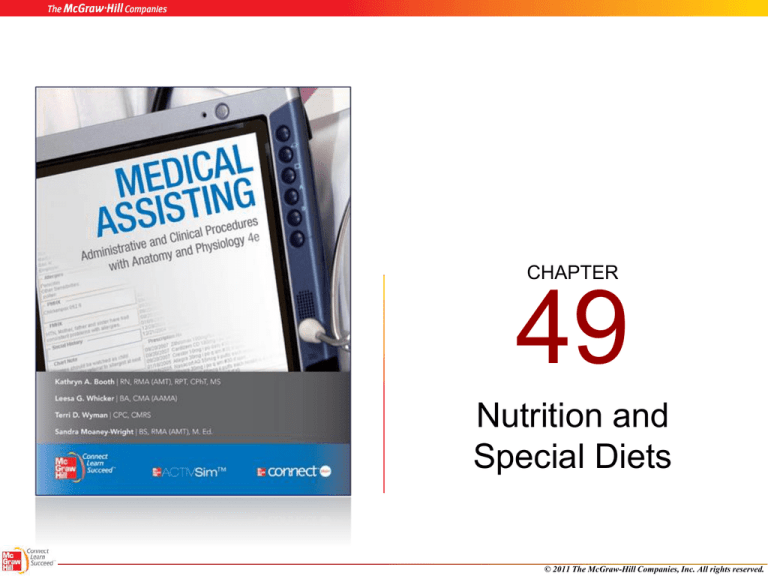
CHAPTER
49
Nutrition and
Special Diets
© 2011 The McGraw-Hill Companies, Inc. All rights reserved.
49-2
Learning Outcomes
49.1 Describe how the body uses food.
49.2 Explain the role of calories in the diet.
49.3 Identify nutrients and their role in health.
49.4 Recall the Dietary Guidelines for Americans.
© 2011 The McGraw-Hill Companies, Inc. All rights reserved.
49-3
Learning Outcomes (cont.)
49.5 Explain how the Food Guide Pyramid can be
used to plan a nutritious, well-balanced diet
and healthy lifestyle.
49.6 Describe the test used to assess body fat.
49.7 Explain reasons why a diet may be modified.
49.8 Identify types of patients who require special
diets and the modifications required for each.
© 2011 The McGraw-Hill Companies, Inc. All rights reserved.
49-4
Learning Outcomes (cont.)
49.9 Describe the warning signs, symptoms, and
treatment for eating disorders.
49.10Educate patients about nutritional
requirements.
49.11Document patient education about nutrition.
© 2011 The McGraw-Hill Companies, Inc. All rights reserved.
49-5
Introduction
• Nutrition
• Medical assistant –
understand
– How the body
relationship between
takes in and utilizes
nutrition and health
food and nutrients
– Five-part process
•
•
•
•
•
Intake
Digestion
Absorption
Metabolism
Elimination
© 2011 The McGraw-Hill Companies, Inc. All rights reserved.
49-6
Daily Energy Requirements
• The body requires
nutrients
– To provide energy
– To build, repair, and
maintain body tissues
– To regulate body
processes
© 2011 The McGraw-Hill Companies, Inc. All rights reserved.
49-7
Metabolism
• The sum of all cellular processes that build,
maintain and supply energy to living tissue
• Phases
– Anabolism – nutrients are changed into more
complex substances that are used to build body
tissues
– Catabolism – complex substances are broken down
into simpler substances and converted to energy
• Metabolism affected by age, weight, activity,
state of health, and other factors
© 2011 The McGraw-Hill Companies, Inc. All rights reserved.
49-8
Calories
• Kilocalorie (calorie)
– Measurement of energy produced by food
– Amount of energy needed to raise the
temperature of 1 kg of water by 1°C.
– Used to measure the energy expended during
activities and metabolic processes
– Excess calories stored as fat
– Count calories of food eaten and estimate
expenditure for activities
© 2011 The McGraw-Hill Companies, Inc. All rights reserved.
49-9
Apply Your Knowledge
1. What is the role of diet in health?
ANSWER: Food is the source of nutrients the body needs to
function properly. Sometimes a special diet is needed to
stay healthy or regain health, and some conditions require
special diets.
2. What is the difference between anabolism and
catabolism?
ANSWER: Anabolism converts nutrients into complex
substances needed to build body tissues. Catabolism
converts complex substances into simpler forms and
converts them into energy.
© 2011 The McGraw-Hill Companies, Inc. All rights reserved.
49-10
Nutrients
• Needed for
–
–
–
–
Energy
Growth
Repair
Basic processes
• Energy is only
provided by
– Proteins
– Carbohydrates
– Fats
• Nutrients are
provided by
–
–
–
–
–
–
–
Proteins
Carbohydrates
Fiber
Lipids
Vitamins
Minerals
Water
© 2011 The McGraw-Hill Companies, Inc. All rights reserved.
49-11
Proteins
• Functions
– Building and repairing
cells and tissues
– Maintaining water
balance
– Antibody production
and disease
resistance
– Maintaining body heat
• 10% to 20% of total
caloric intake daily
• 1 gm = 4 calories
• Deficiency
– Weight loss/fatigue
– Malnutrition
– Lower resistance to
infection
– Interference with
normal growth
processes
© 2011 The McGraw-Hill Companies, Inc. All rights reserved.
49-12
Proteins (cont.)
• Complete proteins
– Contain all 9 essential
amino acids
– Animal food sources
– Recommend lean
meats, low-fat or skim
milk
• Incomplete proteins
– Lack one or more
essential amino acids
– Plant sources
– Can be combined to
provide all 9 essential
amino acids
© 2011 The McGraw-Hill Companies, Inc. All rights reserved.
49-13
Carbohydrates
• Functions
– Provide 2/3 of daily
energy needs
– Provide heat
– Metabolize fats
– Preserve protein for
uses other than
energy production
• 50% to 60% of total
caloric intake daily
• 1 gm = 4 calories
• Deficiency
– Weight loss
– Protein loss
– Fatigue
• Excess contributes to
fat stores
© 2011 The McGraw-Hill Companies, Inc. All rights reserved.
49-14
Carbohydrates (cont.)
• Simple sugars
– Fruits and some
vegetables
– Milk
– Table sugar
• Complex
carbohydrates
• Excess
– Stored in liver and muscles
cells as glycogen
– Converted into and stored as
fat
– Polysaccharides – long
chains of sugar units
– Types
• Starch – major source of
energy
• Fiber
© 2011 The McGraw-Hill Companies, Inc. All rights reserved.
49-15
Fiber
• Does not supply
energy or heat
• Functions
– Increases and softens
the bulk of stool
– Absorbs wastes and
toxins
– Decreases the rate of
carbohydrate
breakdown and
absorption
• 20 – 30 gm per day
for adults
• Types
– Soluble
• Absorbs fluid and
swells when eaten
• Slows absorption
• Helps control blood
glucose
• Lowers cholesterol
– Insoluble – promotes
regular bowel
movements
© 2011 The McGraw-Hill Companies, Inc. All rights reserved.
49-16
Lipids
• Concentrated source
of energy
• 1 gm = 9 calories
• Triglycerides
– Simple lipids
– 95% of dietary lipids
• Cholesterol
– Compound lipids
– 5% of dietary lipids
• Functions
– Provide a
concentrated source of
energy
– Transport fat-soluble
vitamins
– Store energy as body
fat – insulate and
protect organs
– Provide a feeling of
fullness
© 2011 The McGraw-Hill Companies, Inc. All rights reserved.
49-17
Lipids (cont.)
• Saturated fats
– Primarily from
animal sources
– Solid at room
temperature
• Trans fats
• Unsaturated fats
– Liquid at room
temperature
– Types
• Polyunsaturated
• Monounsaturated
– Formed during
hydrogenation of
vegetable oils
– FDA recommends
zero consumption
© 2011 The McGraw-Hill Companies, Inc. All rights reserved.
49-18
Lipids (cont.)
• Cholesterol
– Fat-related substance
produced by liver
– Animal-based food
sources
– Essential to health
• Part of cell membranes
• Structural basis for
steroid hormones and
vitamin D
• Component of bile
• Lipid levels
– High cholesterol
• Heart
disease/stroke
• Peripheral vascular
disease
– Lipoproteins
• Carry lipids
through the
bloodstream
• Low-density (LDL)
• High-density (HDL)
© 2011 The McGraw-Hill Companies, Inc. All rights reserved.
49-19
Vitamins
• Organic substances
– Essential for normal growth
and maintenance
– Essential for resistance to
infection
– Help the body use other
nutrients
– Assist with body processes
• Absorbed through
digestive tract
• Types
– Water soluble – not stored
by the body
– Fat-soluble – stored by the
body
• Well-balanced diet
usually minimizes
likelihood of vitamin
deficiency
© 2011 The McGraw-Hill Companies, Inc. All rights reserved.
49-20
Minerals
• Natural, inorganic
substances
– Build and maintain
tissues
– Carry out life functions
• Major minerals –
needed in large
quantities
• Trace minerals – needed
in small amounts
• Absorbed in intestines
• Established RDAs
–
–
–
–
Calcium
Iodine
Magnesium
Selenium
Zinc
Iron
Phosphorus
© 2011 The McGraw-Hill Companies, Inc. All rights reserved.
49-21
Water
• No caloric value
• 65% of body weight
• Functions
– Maintains fluid balance
– Lubricates moving
parts
– Dissolves chemicals
and nutrients
– Aids in digestion
– Transports nutrients
and secretions
– Flushes out wastes
– Regulates body
temperature
© 2011 The McGraw-Hill Companies, Inc. All rights reserved.
49-22
Water (cont.)
• Fluid balance – intake should equal output
• Patient education
– Explain the importance
of water
– List sources of water
© 2011 The McGraw-Hill Companies, Inc. All rights reserved.
49-23
Principal Electrolytes and Nutrients of Special
Interest
• Electrolytes
– Sodium
• Fluid and acid-base
balance
• Maintains normal
conditions inside and
outside of cells
– Potassium
• Muscle contraction
• Fluid and electrolyte
balance
– Chloride
• Fluid and electrolyte
balance
• Component of
hydrochloric acid
• Antioxidants – chemical
agents that neutralize
free radicals (by-products
of normal metabolism)
© 2011 The McGraw-Hill Companies, Inc. All rights reserved.
49-24
Apply Your Knowledge
Matching:
ANSWER:
F Bulk to stool
___
A. Cholesterol
C Tissue repair
___
B. Antioxidants
___
H Excess stored as glycogen or fat
C. Proteins
___
G Concentrated source of energy
A Produced by liver
___
D. Water
D No caloric value
___
F. Fiber
___
B Neutralizes free radicals
G. Lipids
___
E Formed during hydrogenation
H. Carbohydrates
E. Trans fats
S
U
P
E
R
J
O
B
!
© 2011 The McGraw-Hill Companies, Inc. All rights reserved.
49-25
Dietary Guidelines
• Established to help people
– Get proper nutrition
– Reduce occurrence of disease
– Control weight
• Designed to encourage healthy eating
habits
• Suggest types and quantities of foods
© 2011 The McGraw-Hill Companies, Inc. All rights reserved.
49-26
USDA and U.S. Dept. of Health and Human
Services Dietary Guidelines
• Recommendations
– Adequate nutritional
intake
– Healthy body weight
– Regular physical
exercise
– Increase fruits, low-fat
dairy, and wholegrains
– Limit fats
– Limit alcohol
– Food safety
• Disinfect food surfaces
• Wash hands
• Cook foods to safe
temperature
• Refrigerate foods
• Avoid raw eggs and
meats and
unpasteurized milk or
juices
© 2011 The McGraw-Hill Companies, Inc. All rights reserved.
49-27
USDA Food Guide Pyramid
• Revised in 2005
– Emphasizes fruits,
vegetables, whole
grains, beans, and
nuts
– Less emphasis on
carbohydrates
– Helps balance
nutritional needs with
physical activity needs
• Color coded
–
–
–
–
–
–
Orange – grains
Green – vegetables
Red – fruits
Yellow – oils
Blue – milk products
Purple – meats/beans
• Action figure –
physical activity
Food
Pyramid
© 2011 The McGraw-Hill Companies, Inc. All rights reserved.
49-29
American Cancer Society Dietary Guidelines
• Eat more high-fiber foods
• Five or more servings of fruits and vegetables
daily
• Limit consumption of processed and red meats
• Adopt a physically active lifestyle
• Achieve and maintain a healthy weight
• Limit consumption of alcoholic beverages
© 2011 The McGraw-Hill Companies, Inc. All rights reserved.
49-30
Apply Your Knowledge
Match food group to appropriate color:
ANSWER:
A. Vegetables
B. Oils
C. Meat and beans
D. Grains
E. Fruits
Orange
Purple
Green
Red
Blue
F. Milk products
Yellow
© 2011 The McGraw-Hill Companies, Inc. All rights reserved.
49-31
Assessing Nutritional Levels
•
•
•
•
•
•
Age
Health status
Height/weight
Body frame
Body circumference
% of body fat
• Nutrition and exercise
patterns
• Energy needs
• Also
–
–
–
–
Culture
Beliefs
Lifestyle
Education
© 2011 The McGraw-Hill Companies, Inc. All rights reserved.
49-32
Assessing Nutritional Levels (cont.)
• Measure fat as % of weight
– Skinfold test
• Measurement of the thickness of a fold of skin with
a caliper
• Total % of fat
– Optimal % differs between men and women
– Aging changes ratio – fat replaces muscle
tissue
© 2011 The McGraw-Hill Companies, Inc. All rights reserved.
49-33
Modified Diets
• Factors affecting dietary needs
– Pregnancy
– Injury
– Disease
– Vegetarian diet
– Aging
– Genetic disorders
– Substance abuse
© 2011 The McGraw-Hill Companies, Inc. All rights reserved.
49-34
Modified Diets
• Modifications
– Restriction of certain foods
– Emphasis on particular foods
– Change in daily caloric intake
– Change in the amount of a specific nutrient
– Change in the texture of foods
– Alteration in the number of daily meals
– Change in variables such as bulk or spiciness
© 2011 The McGraw-Hill Companies, Inc. All rights reserved.
49-35
Specific Modified Diets
• For treatment or prevention of
certain conditions
• Modifications include changes in
– Texture
– Frequency and timing
• Liquid or soft
• High-fiber
• Three smaller meals
• Timing in relation to a
procedure
– Nutrient level
– Exclusions – for food
intolerances
• Low sodium
• Reduced calorie
© 2011 The McGraw-Hill Companies, Inc. All rights reserved.
49-36
Specific Modified Diets (cont.)
• Supplements and
parenteral nutrition
– Oral – specially
formulated to provide
adequate nutrients
– Parenteral – given IV
to bypass the digestive
system
• Drug therapy
– Drugs
• Change in food intake
• Change in absorption
– Foods
• Interfere with
metabolism and action
of a drug
© 2011 The McGraw-Hill Companies, Inc. All rights reserved.
49-37
Patients with Specific Nutritional Needs
• Food allergies
– Wheat, milk, eggs, and
chocolate
– Eliminate from diet
• Anemia
– Iron supplements
– Dietary iron
• Cancer
– Increase caloric intake
– Adequate protein intake
• Diabetes
– Food exchange system
– Diabetes food pyramid
• Elderly
– Energy and metabolic
requirements decrease
– Physical difficulties
– Medications
– Social factors
– Economic factors
© 2011 The McGraw-Hill Companies, Inc. All rights reserved.
49-38
Patients with Specific Nutritional Needs
(cont.)
• Lactose sensitivity
– Lactase not present to
break down lactose
• Overweight
– Dietary modification
– Behavior
modification
– Motivation and
education
• Heart disease
– Reduce cholesterol
– Lose weight if needed
– Reduce consumption
of fats
• Hypertension
– Decrease sodium/
increase potassium/
adequate calcium
– Eliminate or reduce
alcohol consumption
© 2011 The McGraw-Hill Companies, Inc. All rights reserved.
49-39
Patients with Specific Nutritional Needs
(cont.)
• Pregnant
–
–
–
–
–
Additional protein
Calcium
Iron
Folic acid
Fiber
• Lactating
– Additional calories and
protein
– Folic acid and calcium
• Children
– 1st year
• Breast milk or
commercial formula
• Cow’s milk inadequate
– Nutritional needs
change
• Growth spurts
• Maturation
• Increasing activity
– Hunger regulates
intake
© 2011 The McGraw-Hill Companies, Inc. All rights reserved.
49-40
Apply Your Knowledge
1. What factors does the physician consider when
assessing a patient’s nutritional status?
ANSWER: The physician considers a patient’s age, health
status, height and weight, body frame and circumference,
percent of body fat, eating and exercise patterns, and
energy needs. Culture, beliefs, lifestyle, and educational
level should also be considered during the assessment.
© 2011 The McGraw-Hill Companies, Inc. All rights reserved.
49-41
Apply Your Knowledge
2. Matching
ANSWER:
___
C Eliminate foods from diet
___
E Food exchange system
___
F Decreased metabolism
Yippee! 2
for 2!
A. Change in texture
B. Children
C. Food allergies
___
B Hunger drives eating
A Modification to a soft diet
___
D. Parenteral nutrition
___
H Reduced sodium diet
F. Elderly
___
D Bypasses GI tract
___
G May alter food intake and absorption
G. Drug therapy
E. Diabetes
H. Change in nutrient level
© 2011 The McGraw-Hill Companies, Inc. All rights reserved.
49-42
Eating Disorders
• Extremely harmful eating behavior
• Anorexia nervosa
– Self-starvation
– Treatment
• Restore normal nutrition
• Psychotherapy
• Education of nutrition concepts
– Chronic condition – can be fatal
© 2011 The McGraw-Hill Companies, Inc. All rights reserved.
49-43
Eating Disorders (cont.)
– Bulimia
• Binge and purge by vomiting, diuretics, laxatives
• Usually easier to treat than anorexia
• Treatment
– Medication
– Psychotherapy
• Goals
– Establish a healthy weight
– Establish good eating patterns
– Resolve psychosocial triggers
© 2011 The McGraw-Hill Companies, Inc. All rights reserved.
49-44
Eating Disorders (cont.)
• Getting help – be alert to patient report of
– Skipping at least two meals per day
– Uncontrolled eating of large amounts of food
– Using laxatives or other purges to control
weight
– Avoiding social situations that interfere with
diet or exercise
– Feeling disgust, depression, and guilt after
binge
– Feeling that food controls life
© 2011 The McGraw-Hill Companies, Inc. All rights reserved.
49-45
Apply Your Knowledge
A young female patient arrives at the clinic showing a 15
pound weight loss in the last two months. Her weight is
10 pounds under the average weight for her height. She
states she “feels great.” What should you do?
ANSWER: Document the weight loss and report it to the
physician. She may be suffering from anorexia nervosa
or bulimia, two types of eating disorders that require
medical care and psychotherapy.
© 2011 The McGraw-Hill Companies, Inc. All rights reserved.
49-46
Patient Education
• Reinforce nutrition
instructions
• Teach patient
– Role nutrition plays in
preventing illnesses
– How to be wise
consumers by reading
food package labels
• Factors
– Patient likes and
dislikes
– Patient age and family
circumstances
– Diseases and
disorders
– Patient’s psychological
condition
© 2011 The McGraw-Hill Companies, Inc. All rights reserved.
49-47
Patient Education (cont.)
• Guidelines
– Teach patient as an individual
– Teach a small amount at a time
– Keep explanations at patient’s level of
understanding
– Reinforce good eating behavior
– Let patient be an active learner
– Provide a written diet plan
– Suggest support groups
© 2011 The McGraw-Hill Companies, Inc. All rights reserved.
49-48
Patient Education (cont.)
• Cultural considerations
– Influence
•
•
•
•
•
Food purchases
Like and dislikes
Meal timing and frequency
Attitude toward supplements
Snacking
– Adjust diet and recipes accordingly
© 2011 The McGraw-Hill Companies, Inc. All rights reserved.
49-49
Apply Your Knowledge
What do you need to consider when teaching
patients about nutrition?
ANSWER: You need to consider patient likes and
dislikes, age and family circumstances, diseases and
disorders, and the patient’s psychological condition. In
addition, you need to incorporate cultural
considerations into nutritional education.
Excellent!
© 2011 The McGraw-Hill Companies, Inc. All rights reserved.
49-50
In Summary
49.1 The body uses food for three major purposes: to
provide energy; to build, repair, and maintain body
tissues; and to regulate body processes.
49.2 Calories provide energy for the body. Calories are
measured in the foods we eat. We can also estimate
the amount of calories used by the body during
activity.
49.3 The body needs a variety of nutrients for energy,
growth, repair, and basic processes. There are several
food components that provide nutrients. These are
proteins, carbohydrates, fiber, lipids, vitamins,
minerals, and water.
© 2011 The McGraw-Hill Companies, Inc. All rights reserved.
49-51
In Summary (cont.)
49.4 Dietary guidelines suggest the types and quantities of
food that people should eat each day. They may also
contain recommendations about which types of foods
to limit and which types of foods to increase.
49.5 The Food Guide Pyramid provides recommendations
for eating a variety of nutrients and maintaining
physical activity. Following the Food Guide Pyramid
recommendations promotes a well-balanced diet and
healthy lifestyle.
49.6 Calipers are used to perform a skinfold test that
determines the percentage of body fat.
© 2011 The McGraw-Hill Companies, Inc. All rights reserved.
49-52
In Summary (cont.)
49.7 Dietary modifications may be used alone or in
combination with other therapies to prevent or treat
illness.
49.8 Patients with allergies, anemia, cancer, diabetes,
advancing age, heart disease, hypertension, lactose
sensitivity, and obesity need special diets. In addition,
pediatric, pregnant, lactating, and debilitated patients,
as well as those undergoing drug therapy, need
modifications to their diet.
© 2011 The McGraw-Hill Companies, Inc. All rights reserved.
49-53
In Summary (cont.)
49.9 You should know the signs and symptoms of eating
disorders in order to evaluate for these disorders
during the patient interview. Some of the more
common signs and symptoms for each include:
– anorexia nervosa – unexplained weight loss, selfstarvation, and fear of weight gain
– bulimia – eating large quantities of food in a short
period of time, going to the bathroom immediately
after eating, and using laxatives to excess
– binge eating – not followed by purging and weight
gain
© 2011 The McGraw-Hill Companies, Inc. All rights reserved.
49-54
In Summary (cont.)
49.10 You may play a major role in educating patients
about special diets and in helping them to implement
dietary changes as instructed by physicians and
dietitians. Knowledge of basic nutritional principles
and current nutritional findings will help you perform
these tasks with confidence and competence.
49.11 Documenting nutritional education is part of
preventative health care practice and is required to
help ensure payment by managed care and other
health insurance companies.
© 2011 The McGraw-Hill Companies, Inc. All rights reserved.
49-55
End of Chapter 49
He that eats till
he is sick must
fast till he is
well.
~English Proverb
© 2011 The McGraw-Hill Companies, Inc. All rights reserved.









